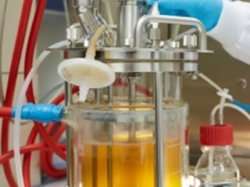Developments in 2,3-butanediol production from biomass

Rehap has been developing 2,3-butanediol (BDO) production from two biomasses in the project, bark and poplar, and here are some of their most recent advances.
In previous research, VTT, the Technical Research Centre of Finland, developed a technique for the hot water extraction of tannins from soft wood bark and successfully transferred it to the lab at BBEPP. At BBEPP, this technique to obtain cellulose and lignin/tannin fractions was performed and evaluated and successfully scaled up to pilot scale.
In parallel to this development, partners TECNALIA have been working on the saccharification – the process of breaking down a complex carbohydrate, in this case cellulose, using hydrolysis into its simplest sugars – of the cellulosic residue generated by the purification of lignin from the woody material, poplar.
Tests have selected the best enzymes and hydrolysis conditions that can increase the glucose yield and minimise the production of inhibitors that could affect the course of fermentation at the next step. The hydrolysate, this is the substance left over from hydrolysis, was best obtained using the purification method, otherwise enzymes remain in their crude form and cannot be used.
Once the substance was obtained, BIOSYNCAUCHO, a company that aims to develop high-added value chemical products from renewable raw materials, tested and determined the best conditions for the fermentation of sugars to 2,3-butanediol (BDO), a renewable chemical building block. Promising results from poplar's second-generation sugars have revealed close comparisons to 2,3-BDO production using first-generation sugars—sugars found in food crops using standard processing technologies.
In other developments, the fermentability of the sugars obtained from bark in BBEPP at pilot scale have also been optimised by BIOSYNCAUCHO with excellent results in terms of 2,3-BDO production, yield and productivity. As found with the process used in poplar, the purification procedures are critical to avoid the presence of inhibitors.
These two results demonstrate that the use of second-generation sugars from agroforestry waste in the Rehap project, obtained after the processing of bark and poplar, is a real alternative to using first-generation sugars for the production of 2,3-BDO, successfully reaching one of the project's vital objectives.
Next stage
The chosen protocols for the enzymatic hydrolysis of cellulose residues from poplar and the fermentability conditions to produce 2,3-BDO are being transferred to BBEPP to scale up and validate all the processes. From here, if successful, the required amount of 2,3-BDO can be used for further project developments.
Provided by Insight Publishers



















